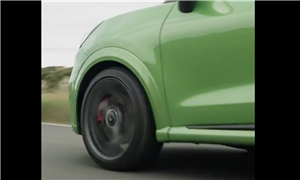The sound of something exciting, from the people who helped make it. Coming September 24th.#PumaST pic.twitter.com/S3le5UQnMf
— Ford Europe (@FordEu) August 5, 2020
Now this is a rather cute way to do a teaser. Ford is showing snippets of the upcoming Ford Puma ST – confirmed to debut on September 24 – on Twitter. “The sound of something exciting, from the people who helped make it. Coming September 24th,” read the caption.
The video shows someone getting into the hot SUV and driving out of the garage. It then goes from city to highway to country roads, and lastly, to a light trail, where the driver gets out to enjoy a lovely view of the lake and mountains. We then get to hear the green Puma ST’s engine and exhaust note as it’s revved.
What’s cute is before that, though. The entire video’s audio was supplied by the Puma ST’s development team, replete with actions mimicking the scene. All done in conference call style, a scene we’ve become familiar with over the past few months. Watch it, even if you don’t find the Puma sexy.
The hot Puma is set to share the Fiesta ST’s 1.5 litre turbocharged three-cylinder with 200 PS and 290 Nm of torque, fed to the front wheels through a six-speed manual gearbox. Word is that an optional limited-slip differential and a launch control function will be available – we’ll see.
This is actually the second time Ford is teasing the Puma ST; the first round was in May. Expect a sportier and more aggressive appearance for the small crossover, plus Recaro seats as per ST versions of the Fiesta and Focus. There aren’t many performance small SUVs around now, but Hyundai is readying a Kona N.
Unveiled in July 2019, the Ford Puma puts an old name (from a coupe) on a new product, an SUV-inspired compact crossover, or a B-segment “Fiesta SUV” if you like.
The regular Puma is powered by a 1.0 litre three-cylinder EcoBoost petrol engine with Ford’s new mild-hybrid system. The 11.5 kW belt-driven integrated starter/generator (BISG) replaces the standard alternator and recoups energy that is traditionally wasted during braking or coasting. This energy is then routed to the lithium-ion battery pack. The BISG provides up to 50 Nm of torque for better acceleration.
Offered in 125 PS and 155 PS variants, the mild hybrid system improves fuel efficiency by up to 9%, Ford claims. More on the Puma here.
Source: Read Full Article
